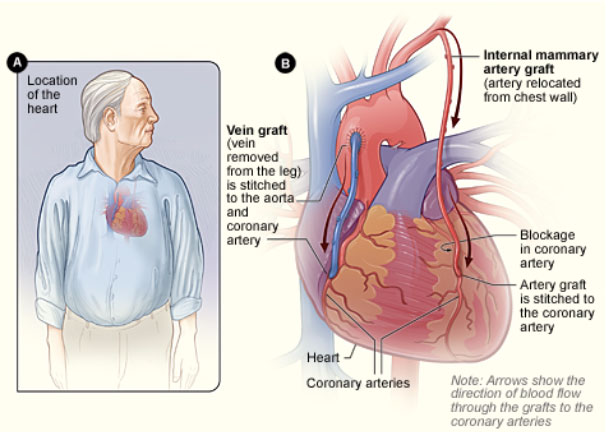Overview
Coronary Artery Bypass Graft surgery (CABG) or bypass surgery is often pronounced as “cabbage” in the medical industry. Since its inception in the 1960s till today, CABG has undergone many developments, both clinically and technically.
What is CABG Surgery?
CABG is performed when the arteries supplying blood to the heart (coronary arteries) are blocked, which can be treated by giving the blood a new pathway to reach the heart muscle. In this procedure, a blood vessel that can be a vein from the leg or an artery from the arm or chest wall is removed to bypass a coronary artery that is narrowed or blocked and restored blood flow to the heart muscle. This vessel is called a graft.
Where do the substitute blood vessels come from?
These substitute blood vessels can come from the chest, legs, or arms. It is safe to use these veins or arteries as other pathways take blood to and from the tissues. Internal mammary arteries located in the chest have been shown to give the best long-term results, with over 90% of grafts working well even after a decade. Saphenous veins from the leg or the radial artery located in the wrist can also be used for this type of surgery. In some cases, only arterial grafts are used while in others a mix of arterial and venous grafts are preferred by the heart specialist performing the surgery. Depending upon the number of coronary arteries blocked, a patient might have to undergo one or more bypass grafts.
Why is the surgery performed?
• To manage the blockage of blood flow to the heart muscle
• To improve the supply of oxygen and blood to the heart
• To relieve chest pain (angina)
• To reduce the risk of a heart attack
• To improve the ability for physical activity
How is the surgery performed?
In a traditional heart bypass surgery, the surgeon makes an incision (about 6 to 8 inches) down the centre of the breastbone to get direct access to the heart. The patient is connected to a heart-lung bypass machine that allows circulation of blood in the duration of the surgery being performed. As the heart stops beating with the help of medication, a breathing tube is inserted in the patient’s mouth. This tube is attached to a ventilator that helps in breathing during and after the surgery.
What is Off-Pump Heart Bypass Surgery?
In Off-pump Heart Bypass Surgery also known as the Beating Heart Bypass Surgery, the surgeon operates while the heart is still beating. Therefore, the heart-lung machine is not required in this procedure. The surgeon makes use of advanced operating equipment to hold certain portions of the heart and bypass the blocked artery. During the procedure, the rest of the heart continues to pump and circulate blood to the patient’s body.
What is Minimally Invasive Heart Bypass Surgery?
MICS CABG or MICAS is a technique where the heart is approached through the side of the chest via a 4 cm incision. The chest is entered through the ribs without cutting any bones and by splitting the muscle. The vessel from the leg to be used for grafting in this type of surgery is removed through an endoscope (a thin surgical tube with a light and camera at the end). This is called Endoscopic Vein Harvesting (EVH). MICS CABG has several advantages such as early discharge of the patient from the hospital, lesser pain, positive effect on breathing, minimal blood loss and low risk of infection.
What is Robotic Heart Surgery?
Individuals who qualify for this surgical procedure have robotic-controlled tools operated on them for replacing or repairing stiff heart valves. It is one of the most minimally invasive heart surgeries as very small incisions are made during the surgery.
Can CABG be combined with stents?
The development of ‘hybrid suites’ that allow for simultaneous or staged CABG and stenting procedures are being conducted. In a little over a century, heart surgeries have transformed drastically. Major advances have made procedures like CABG safer and widely accepted. Continued research into different approaches, methods, and medical interventions can make cardiac surgeries less invasive and further decrease risks in the future.


